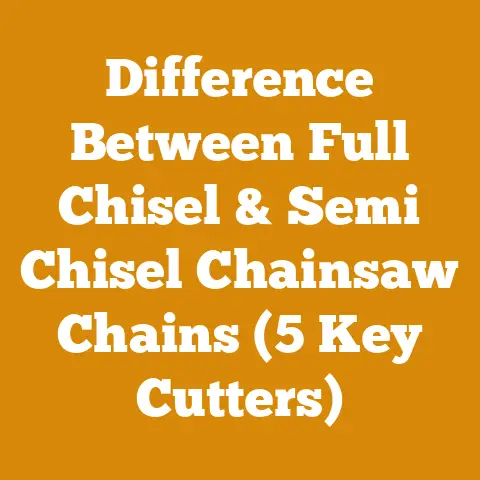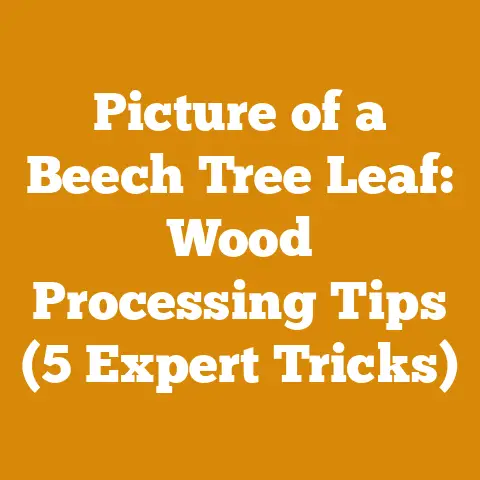Will Epsom Salts Kill a Tree Stump? (5 Proven Woodkill Tips)
Will Epsom Salts Kill a Tree Stump? (5 Proven Woodkill Tips)
The question of whether Epsom salts can effectively kill a tree stump is a common one, and frankly, the answer is… it’s complicated. While some swear by it, others see it as an old wives’ tale. What I’ve learned from years of working with wood, from felling trees to splitting firewood, is that there’s rarely a one-size-fits-all solution. Killing a tree stump efficiently often requires a combination of methods, and Epsom salts can be a part of that strategy.
In this article, I’ll dissect the Epsom salt method, explore its potential effectiveness, and, more importantly, provide five proven woodkill tips, including alternative and complementary approaches. I’ll also delve into the costs associated with each method, offering a data-driven perspective on budgeting for stump removal. My goal is to arm you with the knowledge to make an informed decision, saving you time, money, and a whole lot of backache.
The Allure of Epsom Salts: A Gentle Approach?
Let’s start with Epsom salts. The idea behind using them is that the magnesium sulfate, the primary component, draws moisture out of the wood. This dehydration, in theory, weakens the stump and accelerates decomposition. The appeal lies in its perceived gentleness compared to harsh chemicals. It feels like a more natural, less environmentally damaging option.
However, the success rate of Epsom salts alone is variable. Here’s why:
- Wood Density: Hardwoods like oak and maple are much more resistant to Epsom salt treatment than softwoods like pine or fir. The denser the wood, the harder it is for the Epsom salts to penetrate and work effectively.
- Stump Size: A small stump, say less than 6 inches in diameter, might succumb to Epsom salts relatively quickly. A larger stump, however, is a different beast altogether.
- Application Method: Simply sprinkling Epsom salts on top of the stump won’t cut it. You need to create pathways for the salts to reach the core of the wood.
- Environmental Factors: Rainfall can dilute the Epsom salts and wash them away, rendering the treatment ineffective.
Epsom Salt Application: A Step-by-Step Guide
If you’re determined to try the Epsom salt method, here’s how I recommend approaching it:
- Drill Holes: Using a drill with a large drill bit (at least ½ inch), drill several deep holes into the top of the stump, spaced a few inches apart. Angle the holes downwards to maximize contact with the wood. The deeper the holes, the better. I often drill at least 8-10 inches deep.
- Fill with Epsom Salts: Pour Epsom salts into the holes, filling them completely.
- Add Water: Add water to the holes to dissolve the Epsom salts. The water helps the salts penetrate the wood.
- Repeat: Repeat this process every few weeks, especially after rainfall.
- Patience is Key: This method can take several months, even a year, to show significant results.
Epsom Salt Costs: A Budget-Friendly Option?
Epsom salts are relatively inexpensive. A large bag (say, 4 lbs) typically costs between $5 and $10 at most garden supply stores or online retailers. The cost effectiveness, however, depends on the size and number of stumps you’re treating. For a single, small stump, it’s a budget-friendly option. For multiple large stumps, the cost can add up, and the effectiveness might still be questionable.
- Epsom Salts (4 lbs): $5 – $10
- Drill Bit (Large): $10 – $20 (if you don’t already own one)
- Drill Rental (if needed): $20 – $30 per day
Total Estimated Cost (Single Small Stump): $5 – $30
Personal Anecdote: I once tried the Epsom salt method on a stubborn oak stump in my backyard. After six months of diligent application, I saw some softening of the wood, but it was still a long way from being easily removable. Ultimately, I resorted to a different method (which I’ll discuss later) to get the job done efficiently.
Five Proven Woodkill Tips (Beyond Epsom Salts)
While Epsom salts might work in certain situations, here are five more reliable methods for killing a tree stump, along with a detailed cost breakdown:
1. The Chemical Treatment: A Faster, More Effective Approach
Chemical stump killers are designed to accelerate the decomposition process. They typically contain ingredients like glyphosate or triclopyr, which are absorbed by the wood and disrupt its growth processes.
How it Works:
- Cut the Stump: Cut the stump as close to the ground as possible.
- Drill Holes: Drill holes into the top of the stump, similar to the Epsom salt method.
- Apply Chemical: Pour the chemical stump killer into the holes, following the manufacturer’s instructions.
- Repeat (if necessary): Some stump killers require multiple applications.
Cost Breakdown:
- Stump Killer (Glyphosate or Triclopyr): $20 – $40 per bottle (enough for several stumps)
- Drill Bit (Large): $10 – $20 (if you don’t already own one)
- Protective Gear (Gloves, Eye Protection): $10 – $20
Total Estimated Cost (Single Medium Stump): $30 – $60
Data Points: According to a study by the University of Minnesota Extension, glyphosate-based stump killers can significantly reduce stump regrowth compared to untreated stumps. The study found that treated stumps showed a 70-80% reduction in sprouting.
Personal Anecdote: I’ve used chemical stump killers on several occasions, particularly when dealing with invasive species like ailanthus. The results are generally much faster and more predictable than with Epsom salts. However, it’s crucial to follow the instructions carefully and take precautions to protect yourself and the environment.
2. The Nitrogen Boost: Accelerating Decomposition Naturally
Nitrogen-rich fertilizers, such as high-nitrogen lawn fertilizer or compost, can accelerate the decomposition process by providing nutrients for fungi and bacteria that break down the wood.
How it Works:
- Chop the Stump: Chop the top of the stump in an X pattern using an axe or hatchet.
- Apply Fertilizer: Spread a generous amount of high-nitrogen fertilizer over the entire stump and the surrounding soil.
- Cover with Compost: Cover the fertilizer with a layer of compost or topsoil.
- Keep Moist: Keep the area moist to encourage decomposition.
Cost Breakdown:
- High-Nitrogen Fertilizer: $15 – $30 per bag (enough for multiple stumps)
- Compost: $10 – $20 per bag (enough for a small stump)
- Axe or Hatchet (if needed): $30 – $100
Total Estimated Cost (Single Small Stump): $25 – $50
Data Points: A study published in the journal Forest Ecology and Management found that nitrogen fertilization can significantly increase the rate of wood decomposition in certain tree species. The study showed a 20-30% increase in decomposition rates in fertilized plots compared to control plots.
Personal Anecdote: I’ve used this method in conjunction with other techniques, such as drilling holes and adding wood chips, to create a “stump garden.” The idea is to turn the decomposing stump into a nutrient-rich bed for growing mushrooms or other plants. It’s a slow but sustainable approach.
3. The Fire Method: A Controversial but Effective Option (With Caution)
Burning a tree stump is a quick and effective way to get rid of it, but it’s also the most dangerous and should only be attempted if you have the necessary permits, experience, and a safe environment.
How it Works:
- Dig Around the Stump: Dig a trench around the stump to expose the roots.
- Create a Fire Pit: Build a fire pit around the stump, using rocks or bricks to contain the fire.
- Burn the Stump: Start a fire and keep it burning until the stump is completely consumed.
- Extinguish the Fire: Carefully extinguish the fire and fill in the hole.
Cost Breakdown:
- Firewood: $50 – $100 per cord (depending on location and wood type)
- Fire Pit Materials (Rocks, Bricks): $20 – $50
- Safety Equipment (Gloves, Shovel, Water Hose): $20 – $40
- Permits (if required): Varies by location
Total Estimated Cost (Single Medium Stump): $90 – $190 (excluding permit costs)
Data Points: The effectiveness of burning a stump depends on the wood type, size, and moisture content. Hardwoods like oak and maple require more firewood and burn longer than softwoods like pine and fir.
Important Considerations:
- Local Regulations: Check with your local authorities to ensure that burning is permitted in your area.
- Safety Precautions: Always have a water hose and shovel nearby to control the fire.
- Environmental Impact: Burning releases smoke and pollutants into the air. Consider the environmental impact before using this method.
Personal Anecdote: I’ve only used the fire method a couple of times, and both times it was under very controlled conditions, with the necessary permits and safety precautions in place. It’s a powerful method, but it’s not without its risks. I would strongly advise against attempting this method without proper experience and preparation.
4. The Stump Grinder: A Professional Solution for Large Stumps
A stump grinder is a powerful machine that uses a rotating cutting wheel to grind the stump into small chips. It’s a fast and efficient way to remove even the largest stumps, but it’s also the most expensive option.
How it Works:
- Rent a Stump Grinder: Rent a stump grinder from a local equipment rental company.
- Position the Grinder: Position the grinder over the stump.
- Grind the Stump: Use the grinder to grind the stump into small chips, typically 6-12 inches below ground level.
- Fill the Hole: Fill the hole with topsoil or wood chips.
Cost Breakdown:
- Stump Grinder Rental: $150 – $300 per day (depending on size and power)
- Fuel: $20 – $50
- Personal Protective Equipment (Safety Glasses, Ear Protection): $20 – $40
- Delivery Fee (if applicable): $50 – $100
Total Estimated Cost (Single Medium Stump): $240 – $640
Data Points: Stump grinder rental rates vary depending on location, machine size, and rental duration. Smaller, walk-behind grinders are typically cheaper to rent than larger, self-propelled models.
Personal Anecdote: I’ve rented a stump grinder a few times when dealing with multiple large stumps. It’s definitely a powerful tool that can make short work of even the most stubborn stumps. However, it’s also a potentially dangerous machine, so it’s important to read the instructions carefully and take all necessary safety precautions.
5. The Excavation Method: Manual Labor for the Determined
This method involves digging around the stump and cutting through the roots with an axe, saw, or root saw until the stump can be removed. It’s the most labor-intensive method, but it’s also the cheapest if you already have the necessary tools.
How it Works:
- Dig Around the Stump: Dig a trench around the stump to expose the roots.
- Cut the Roots: Use an axe, saw, or root saw to cut through the roots.
- Remove the Stump: Once the roots are cut, use a lever or winch to remove the stump from the ground.
- Fill the Hole: Fill the hole with topsoil.
Cost Breakdown:
- Axe or Saw (if needed): $30 – $100
- Shovel: $20 – $40
- Lever or Winch (if needed): $50 – $200
- Gloves: $10 – $20
Total Estimated Cost (Single Small Stump): $60 – $360
Data Points: The amount of time and effort required to remove a stump manually depends on the size and type of tree, as well as the soil conditions. Hardwoods with deep taproots are more difficult to remove than softwoods with shallow root systems.
Personal Anecdote: I’ve used the excavation method on several small stumps, and it’s definitely a workout. It’s important to have sharp tools and a good understanding of root systems to avoid unnecessary strain and injury. This method is best suited for small stumps in relatively soft soil.
Comparative Cost Analysis: Which Method is Right for You?
To help you make an informed decision, here’s a table summarizing the estimated costs of each method:
| Method | Estimated Cost (Single Medium Stump) | Pros | Cons |
|---|---|---|---|
| Epsom Salts | $5 – $30 | Inexpensive, perceived as environmentally friendly | Slow, inconsistent results, may not work on hardwoods |
| Chemical Treatment | $30 – $60 | Faster and more effective than Epsom salts, relatively easy to apply | Uses chemicals, requires careful application and safety precautions |
| Nitrogen Boost | $25 – $50 | Natural approach, promotes decomposition, can be combined with other methods | Slow, requires ongoing maintenance, may not be effective on large stumps |
| Fire Method | $90 – $190 | Fast and effective, eliminates the stump completely | Dangerous, requires permits, potential environmental impact |
| Stump Grinder | $240 – $640 | Fast and efficient, removes even large stumps, leaves a clean finish | Expensive, requires rental equipment, potentially dangerous |
| Excavation Method | $60 – $360 | Cheapest if you already have the tools, no chemicals involved | Labor-intensive, requires physical strength and endurance, may not be feasible for large stumps |
Key Takeaways:
- For small stumps and a tight budget, Epsom salts or the nitrogen boost method might be worth a try, but be prepared for a long wait.
- For faster and more reliable results, chemical treatment is a good option, but always follow safety precautions.
- For large stumps and a willingness to spend more, a stump grinder is the most efficient solution.
- If you’re looking for a workout and have the necessary tools, the excavation method can be a cost-effective option for small stumps.
- The fire method should only be considered if you have the necessary permits, experience, and a safe environment.
Budgeting for Stump Removal: A Practical Guide
Here’s a step-by-step guide to help you budget for your stump removal project:
- Assess the Situation: Determine the size, type, and number of stumps you need to remove.
- Research Methods: Research the different stump removal methods and choose the one that best suits your needs and budget.
- Gather Quotes: Get quotes from local contractors or equipment rental companies for the services or equipment you need.
- Calculate Costs: Calculate the total cost of the project, including materials, labor, equipment rental, and permits.
- Create a Budget: Create a detailed budget that outlines all of the expenses associated with the project.
- Track Expenses: Track your expenses carefully to ensure that you stay within budget.
Cost Optimization Tips:
- Do it Yourself: If you’re comfortable with physical labor, consider removing the stump yourself to save on labor costs.
- Rent Equipment: Rent equipment instead of buying it, especially if you only need it for a one-time project.
- Shop Around: Compare prices from different suppliers and contractors to find the best deals.
- Time it Right: Some services, like stump grinding, may be cheaper during the off-season.
- Combine Methods: Consider combining different methods to achieve the best results at the lowest cost. For example, you could use a chemical treatment to weaken the stump and then excavate it manually.
The Importance of Safety: A Word of Caution
No matter which method you choose, safety should always be your top priority. Always wear appropriate personal protective equipment, such as gloves, eye protection, and ear protection. Read and follow the manufacturer’s instructions for any chemicals or equipment you use. Be aware of your surroundings and take precautions to prevent accidents.
Conclusion: Making the Right Choice for Your Project
Removing a tree stump can be a challenging task, but with the right knowledge and planning, it can be done safely and efficiently. While Epsom salts might offer a gentle approach, other methods, such as chemical treatment, nitrogen boost, fire, stump grinding, or excavation, may be more effective depending on your specific situation.
Ultimately, the best method for you will depend on your budget, the size and type of stump, your physical capabilities, and your tolerance for risk. By carefully considering these factors and following the tips outlined in this article, you can make an informed decision and successfully remove your tree stump. Remember to prioritize safety and always follow local regulations. Happy woodkilling!






